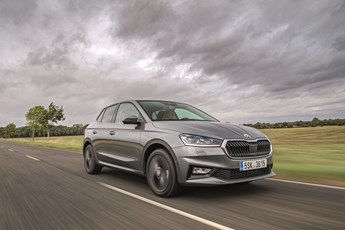We use cookies to ensure that we give you the best experience on our website. If you continue without changing your settings, we will assume that you are happy to receive all cookies on the Business Car website. However, if you would like to, you can change your cookies at any time

The start point for the best source of fleet information |
Model update: Skoda Fabia SE-L
Date: 08 June 2022 | Author: Martyn Collins

|
|
||||||||||||||||||||
Right from the launch of the first-generation Fabia at the start of the noughties, Skoda's supermini has been a high-value package that seemed to offer more than its sister models (Volkswagen Polo, Seat Ibiza). In fact, on some occasions the Fabia has proved to be the pick of these cars.
As we found when we drove an early left-hand drive model for the first time, that high value package remains unchanged. However, for this fourth-generation Fabia, Skoda has made it stiffer, stronger and most importantly, bigger than before - thanks to being built on the Volkswagen Group MQB-AO modular platform. This is also used on Skoda's Kamiq and Scala models.
Outside, the look of the latest Fabia is more evolutionary than revolutionary. In fact, in our test car's optional Graphite Grey Metallic paint finish (£610), we reckon you might have to take a second look to spot the differences over the previous third-generation model at a distance. The big giveaway at the front are the large LED-lit headlights that are seamlessly integrated with the latest version of the chrome-edged grille. At the side, it's the sharp shoulder line, that runs from the front wing to the rear quarter that marks this Fabia out. The high-set rear window and large rear light clusters that spread across the boot characterise this Skoda's rear design. Our test car was also specified with £470 of optional 17in Procyon black metallic alloy wheels, which suited the design and filled the Fabia's arches well.
Inside, the new dashboard design is attractive and classy. Although with the darker middle dashboard trim fitted to this test car, it's harder to hide the fact that this textured trim and dashboard are hard. Still, there's an overall feeling of quality in the Fabia, which is helped by the standard Piano Black trim and optional (£465) Virtual Cockpit with digital instruments. Elsewhere, there are welcome physical controls for the ventilation, but the Volkswagen sourced, larger 9.2in infotainment system remains slower and fiddlier than it should be.
Space in the front of the Fabia is good and the driving position excellent - whatever height you are. Sadly, the Fabia's rear space is more compromised and no better than average. The 380-litre boot matches many cars a size up, but we would have preferred to have less boot space and more rear legroom. We're also not fans of the panoramic glass roof option without the blind, as it noticeably heats up this Skoda's interior, and the ventilation and air-conditioning systems struggle
to cope.
The latest Fabia has not yet been tested by Euro NCAP, but there is no reason to think it would not perform as well as its Volkswagen Group sister cars.
Autonomous emergency braking with pedestrian and cyclist detection is fitted as standard, along with lane-keeping assistance.
Our test car was fitted with the most powerful 110hp, 1.0-litre TSI petrol; it also comes with six-speed manual transmission - which makes for more refined long-distance drives. The engine itself is best-described as a willing but refined performer that seems well matched to the six-speed manual. Although, there's not much difference in terms of performance with the 95hp version, which is predicted to be the best-seller. Although both engines share the same 28% BIK figure, it's the 95hp version that has the marginally lower CO2 output (116g/km) and a £350 lower P11D figure at £19,740.
There are rumours of an incoming baby Skoda electric model, but until then you'll have to make do with ICE power and assume platform limitations. The incoming model means there is no hybrid or EV version. Despite the optional 17in wheels, another new Fabia highlight remains unchanged - the ride, which is sophisticated and comfortable. Although, this comfort perhaps comes at the expense of dynamism this Skoda is still a tidy handler. We just wish there was more feel from the over-light steering.
Still, even with the long list of options on our test car, go without and its £19,730 price seems reasonable. The all-new Skoda Fabia might not be the class-leader, but like before it's a polished all-rounder.
Skoda Fabia 1.0 TSi SE L
P11D: £20,090
Residual value: 44.3%
Depreciation: £11,190
Fuel: £7,991
Service, maintenance and repair: £1,777
Cost per mile: 34.93p
Fuel consumption: 55.4mpg
CO2 (BIK %): 117g/km (27%)
BIK 20/40% a month: £93/£187
Luggage capacity: 380 litres
Engine size/power: 999cc/110hp
Verdict |
8/10 |
|||
 |
|
 |
|
|











